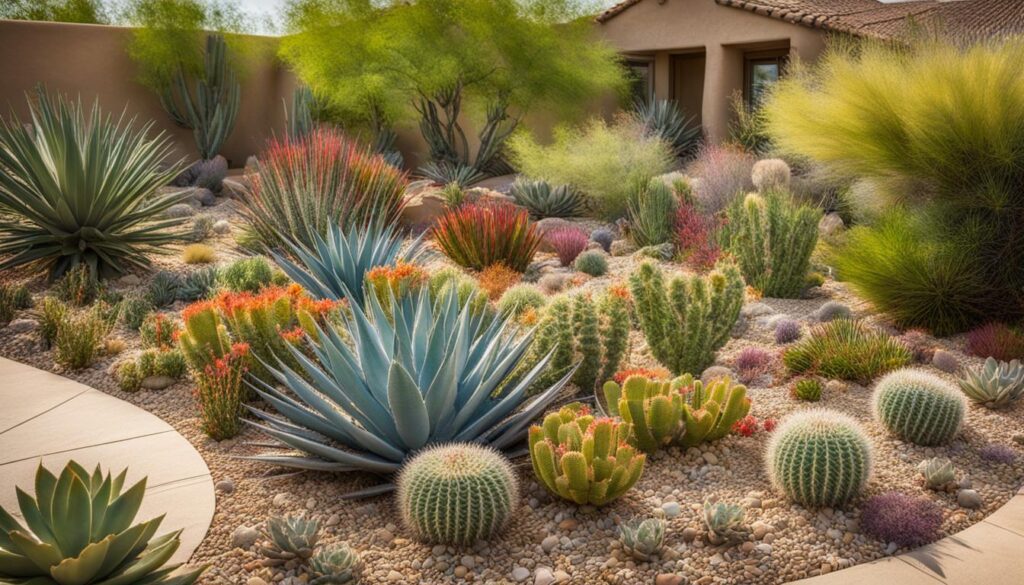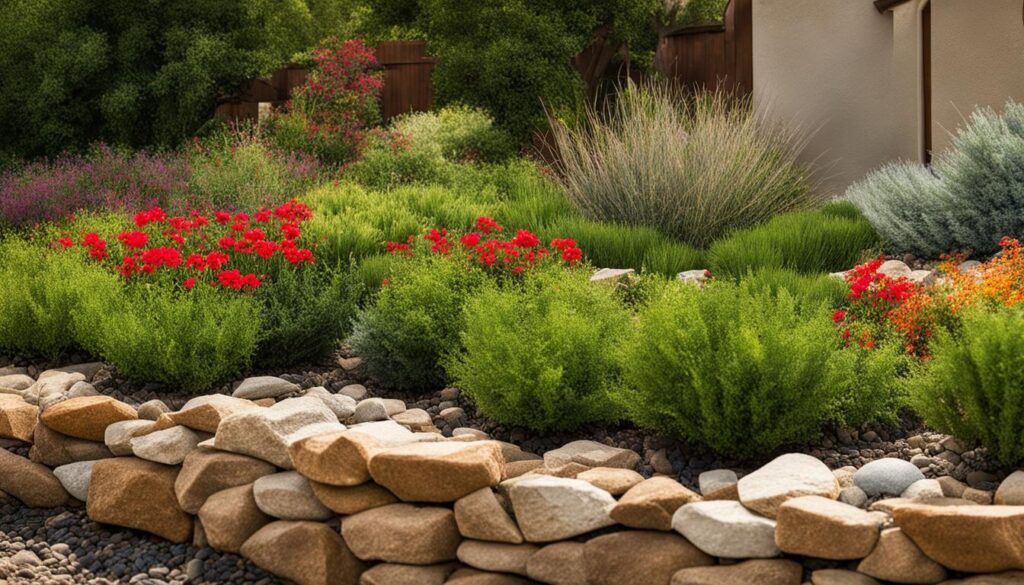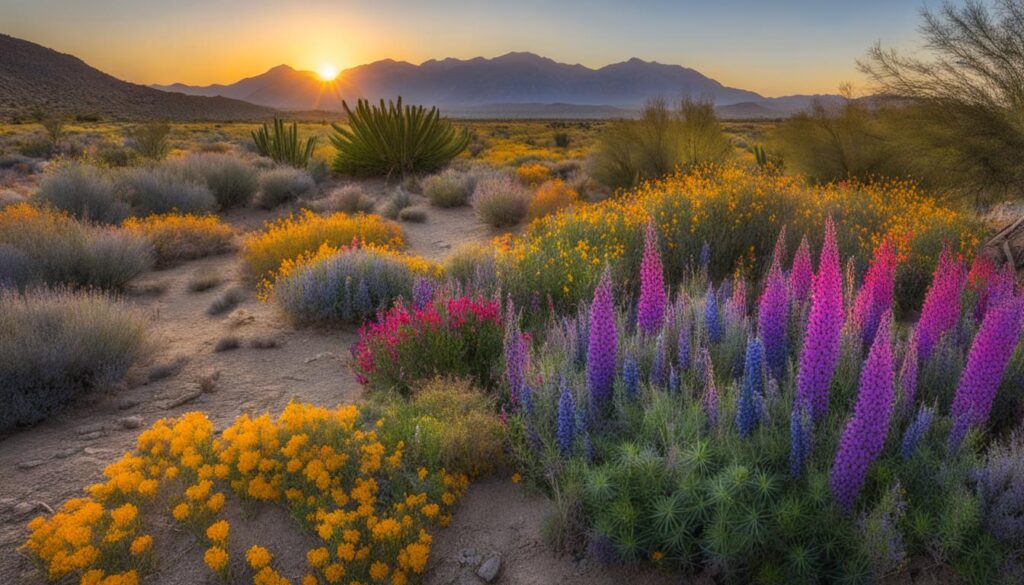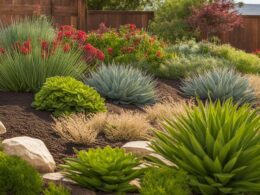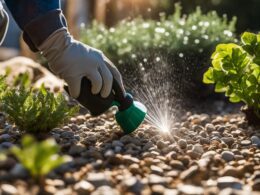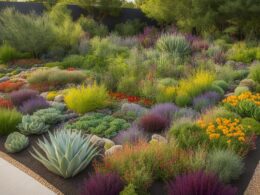Are you tired of dealing with high water bills and spending hours maintaining your landscape in arid climates? Look no further than xeriscaping! Xeriscaping is a sustainable alternative to traditional landscaping practices that can revolutionize your outdoor space. By implementing water-efficient design principles and carefully selecting appropriate plant species, xeriscaping offers a range of benefits that will not only conserve water but also reduce maintenance and create a stunning landscape.
With xeriscaping, you can transform your outdoor environment into a beautiful oasis while being mindful of the unique challenges posed by arid climates. By reducing water requirements and utilizing indigenous species, you can create a picturesque landscape that thrives in harmony with its surroundings.
Key Takeaways:
- Xeriscaping is a sustainable alternative to traditional landscaping in arid climates.
- It promotes water conservation through efficient planning and design.
- Xeriscaping reduces maintenance costs by requiring less water and upkeep.
- The use of indigenous species in xeriscaping benefits biodiversity and supports the local ecosystem.
- Efficient irrigation techniques and grouped planting optimize water usage and reduce evaporation.
Xeriscaping for Sustainability
When it comes to sustainable landscaping practices, xeriscaping is a frontrunner. This method focuses on water efficiency, local habitat preservation, and supporting biodiversity. By implementing xeriscaping techniques, you can reduce water usage, minimize habitat conversion, and contribute to the overall sustainability of your environment.
Xeriscaping achieves water efficiency by employing design principles that optimize water usage. This includes using native plant species that are well-suited to the local climate and require less water than exotic plants. By choosing plants that are adapted to the natural rainfall patterns of your area, you can significantly reduce the amount of water needed for irrigation.
“Xeriscaping conserves precious water resources while still creating beautiful outdoor spaces.”
Not only does xeriscaping promote water conservation, but it also plays a vital role in supporting local habitat and biodiversity. By using native plant species, you can help restore and preserve the local ecosystem. Native plants provide food and shelter for local wildlife, supporting the intricate web of life that exists in your area. Xeriscaping also reduces the risk of invasive exotic species, which can outcompete and displace native plants, disrupting the delicate balance of the ecosystem.
Recreation and Enjoyment
Aside from its ecological benefits, xeriscaping can also enhance recreational opportunities. By creating a well-designed landscape with native plantings, you can transform your outdoor space into a beautiful and inviting oasis. Whether you’re enjoying a morning cup of coffee on your patio or hosting a backyard barbecue, xeriscaping provides a stunning backdrop for all of your outdoor activities.
- Water-efficient design principles
- Native plant species selection
- Habitat conservation
- Recreational opportunities
With xeriscaping, you can have a beautiful, sustainable landscape that supports local habitat, conserves water, and provides a space for relaxation and enjoyment.
Water and Cost Savings
Xeriscaping offers significant water savings compared to traditional landscaping methods. Studies have shown that water-efficient landscapes can save up to 80% of water usage. By implementing xeriscaping techniques such as efficient irrigation systems and appropriate plant selection, you can drastically reduce the amount of water needed to maintain your landscape.
Not only does xeriscaping save water, but it also leads to cost savings. With reduced water usage, you’ll see a decrease in your water bill. Additionally, xeriscaping requires less maintenance, resulting in lower labor costs and a reduction in the need for fertilizers, fuel, and herbicides. These cost savings can significantly contribute to your overall budget.
Water Savings
Implementing xeriscaping practices can result in substantial water savings for your property. By designing your landscape with water efficiency in mind, you can minimize water waste and maximize the utilization of available resources. Using drip irrigation and soaker hoses, which deliver water directly to the base of plants, can significantly reduce water evaporation compared to traditional sprinklers. Grouping plants with similar water needs together ensures that each plant receives the appropriate amount of water without any excess waste.
Cost Savings
The water savings achieved through xeriscaping translates into tangible cost savings. With reduced water usage, you’ll see a significant decrease in your water bills over time. Additionally, xeriscaping requires less maintenance compared to traditional landscapes, resulting in lower labor costs. You’ll also save on expenses related to fertilizers, fuel, and herbicides. These cost savings can add up and contribute to your overall financial well-being.
Indigenous Species and Biodiversity
When it comes to xeriscaping in arid climates, the use of indigenous species plays a crucial role in preserving biodiversity. By incorporating native plants into your landscape, you not only create a stunning outdoor space but also contribute to the restoration and protection of local habitats.
One of the key advantages of using indigenous species is their ability to prevent the invasion of exotic plants. Exotic species, if left unchecked, can outcompete and displace native flora, leading to a decline in biodiversity. By planting native plants, you help maintain the delicate balance of the ecosystem and promote the survival of native flora and fauna.
The importance of preserving biodiversity cannot be overstated. It not only enhances the natural beauty of your surroundings but also provides numerous benefits. A diverse range of plant and animal species helps maintain ecological stability, supports pollinators and other beneficial insects, and contributes to the overall health of ecosystems. By embracing xeriscaping and prioritizing the use of indigenous species, you are actively contributing to the well-being of both your local environment and the larger urban ecosystem.
The Impact of Indigenous Species on Biodiversity
“Native plants are fundamental to sustaining the web of life, providing food and shelter for insects, birds, and other wildlife. They co-evolved over long periods with native insects, birds, and other wildlife and are specifically adapted to local conditions, making them more resilient in the face of climate change. Replacing native plants with exotic species disrupts the intricate relationships between plants and wildlife, leading to a loss of biodiversity and ultimately impacting the health and resilience of ecosystems.”
Benefits of Indigenous Species in Xeriscaping
- Preservation of local biodiversity
- Support for pollinators and other beneficial insects
- Enhancement of ecosystem health and resilience
- Reduction of ecological damage caused by invasive exotic species
Efficient Irrigation and Maintenance
Efficient irrigation is a crucial element of xeriscaping in arid climates. By implementing water-saving techniques, you can maximize the effectiveness of every drop, ensuring that your plants receive the moisture they need while minimizing wastage. Drip irrigation and soaker hoses are excellent options for efficient water distribution. These methods deliver water directly to the base of the plants, reducing evaporation compared to traditional sprinklers. With the precise targeting of water, you can optimize the usage and minimize water loss, ultimately saving both water and money.
To further enhance water efficiency, consider grouping plants with similar water needs together. This strategic arrangement allows you to provide adequate hydration to each cluster without overwatering or underwatering certain plants. By grouping, you can tailor your irrigation schedule to meet the requirements of different plant types, ensuring their optimal health and growth while conserving water.
In addition to efficient irrigation, xeriscaping requires less maintenance compared to traditional landscapes. With the reduction in water-intensive plants and the replacement of thirsty lawns, you can significantly lower the amount of time, effort, and resources spent on maintenance tasks. This means less mowing, fertilizing, and weed control, resulting in reduced labor and associated costs. With the right selection of drought-tolerant plants and proper soil management, you can enjoy a beautiful, low-maintenance landscape that thrives even in arid climates.
Key Points:
- Implementing efficient irrigation techniques such as drip irrigation and soaker hoses can minimize water evaporation and optimize water usage.
- Grouping plants with similar water needs helps ensure efficient watering and prevents overwatering or underwatering.
- Xeriscaping requires less maintenance compared to traditional landscapes, saving time, effort, and resources.
- Choosing drought-tolerant plants and maintaining proper soil conditions are essential for a low-maintenance, water-efficient landscape.
What Are the Benefits of Using Climate-Appropriate Plants for Xeriscaping in Arid Climates?
Using climateappropriate xeriscaping plants in arid climates offers numerous benefits. These plants are well-suited to the local environment, requiring minimal water and maintenance. They can help conserve water, reduce the need for irrigation, and promote sustainable landscaping practices. Additionally, they can thrive in challenging conditions, adding beauty to the landscape.
Conclusion
Xeriscaping is the perfect solution for arid climates, offering a multitude of benefits including water conservation, reduced maintenance, and the creation of stunning landscapes.
By implementing water-efficient design principles and utilizing native plant species, you can contribute to the sustainability of your environment while still enjoying the beauty of a well-designed landscape.
Efficient irrigation techniques, such as drip irrigation and grouping plants with similar water needs, further optimize water usage, minimizing waste and maximizing the impact of every precious drop. As a result, you not only conserve water but also reduce maintenance efforts, saving both time and money.
So, whether you’re a homeowner or a property owner, consider xeriscaping as a practical and eco-friendly choice for creating beautiful and sustainable outdoor spaces in arid climates. Embrace xeriscaping and transform your landscape into a water-wise, low-maintenance haven that showcases the natural beauty of your surroundings.






